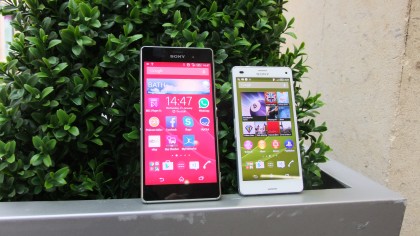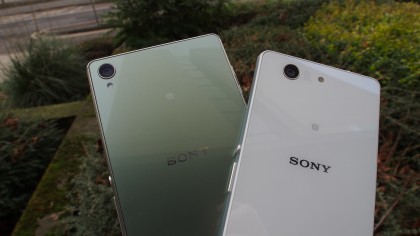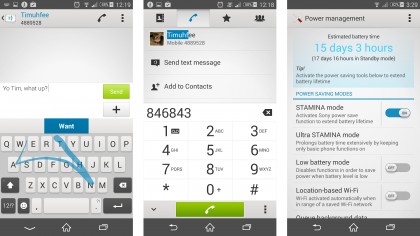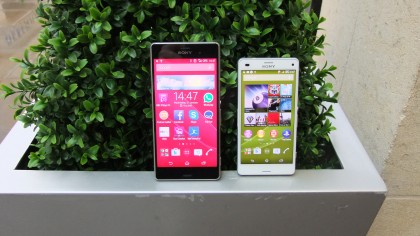Sony Xperia Z3 vs Xperia Z3 Compact
Is it worth going large with Sony's latest handsets?
Interface and performance
Both the Xperia Z3 and the Xperia Z3 Compact come with Android 4.4 installed with a tweaked interface that doesn't bring any huge differences or innovations to the stock Android experience, but adds a few Sony-centric themes, icons and apps.
Because of this the initial experience is remarkably similar on both handsets, although the user interface has been scaled up for the Z3, but thanks to the increased screen resolution everything looks clear and sharp.

On the smaller screen the interface looks good and works pretty decently as well, so again it really depends on your preference for screen size.
The slightly beefed up specs of the Xperia Z3 means that Android 4.4 still feels as smooth as on the Xperia Z3 Compact, despite the more demanding higher resolution screen.
An important thing to note, however, is that while both smartphones offer the same positive experiences of Android 4.4 with the custom Sony interface, it means they also share some of the negatives as well, with apps on both phones sometimes crashing and becoming unresponsive.
This is particularly evident when you try to film in 4K video on either handset, as both devices quickly overheat, causing the Camera app to stop working.
Sony has confirmed that the Xperia Z3 will be updated to Android 5.0 Lollipop sometime in February 2015, and although we don't have a date for when the Z3 Compact is being updated to the latest version of Google's mobile operating system, Sony has promised that it will be updating the smaller handset to Android 5.0 Lollipop as well.
Get daily insight, inspiration and deals in your inbox
Sign up for breaking news, reviews, opinion, top tech deals, and more.
For the most part Sony has done a commendable job of keeping the hardware specifications between the Z3 and Z3 Compact pretty equal.
While other companies often cut the specs as well as the size when they bring out a compact version of a flagship smartphone (just compare the HTC One Mini 2's specifications to the larger HTC One M8), Sony has stuck a lot of the premium hardware found in the Z3 in the Z3 Compact.
The Xperia Z3 and the Z3 Compact share the same Snapdragon 801 chipset with Adreno 330 GPU and 16GB of internal storage (although the Z3 can also come with 32GB).
Due to the similarity in specifications the results of the Geekbench 3 benchmark tests we ran on the handsets were also pretty close, with the Xperia Z3 scoring 2737 and the Z3 Compact netting 2798.
While the Z3 Compact has a respectable 2GB of RAM, the Xperia Z3 boosts this to 3GB to help keep Android running smoothly on the higher resolution screen.
The fact that the same Adreno 330 GPU is featured in both handsets means that gameplay can feel slightly smoother on the Z3 Compact, where the graphics processing unit is only displaying 720p graphics.
When running at 1080p resolution on the Z3, the Adreno 330 GPU can struggle, but that said, graphics look superior on the full size Z3, so you may find a slight hit on frame rates is a worthwhile sacrifice.
Battery
With the bigger body of the Xperia Z3 it's little surprise that Sony has seen fit to include a larger battery, with a capacity of 3100 mAh, compared to the Z3 Compact's 2600 mAh.
Although on paper the Z3 should have a markedly increased battery life, in reality a lot of the benefit from the larger capacity is negated by the additional power it takes to display content on the larger higher resolution screen.

In our battery test, where we have a high definition video playing full brightness, the Xperia Z3 Compact's battery dropped by 23% down to 77% after 90 minutes. During the exact same test the Xperia Z3 actually did worse despite its larger capacity, dropping 31%, leaving just 69% of the battery left.
This clearly demonstrates that the larger 1080p screen comes at a cost to battery life, so if you're not too bothered about full high definition graphics and videos and value a longer lasting handset, then the Xperia Z3 Compact is the smartphone to go for.
In day to day use both handsets can go around a day and a half on battery life, though less if you're an avid game player, or web surfer. They also come with the same power saving settings as well which can help you eke out a few more hours away from a power socket.
If you rely heavily on your phone and go for long periods of time between being able to charge the device, then the fact that the Xperia Z3 Compact is better at holding on to its battery life is definitely worth consideration.
If you're never too far from a charge point or power socket, then this won't be such an issue, though you'll find yourself waiting a bit longer as the Z3 refills its bigger battery.
Camera
Sony has plenty of experience thanks to its camera division, so it's not surprising to see some pretty impressive technology here including 20.7 megapixel resolution, an Exmor RS sensor, a Bionz processor and G Lens technology.

It's once again great to see that Sony has included the same snapper in both handsets, rather than cutting down the Z3 Compact's capabilities and this means that both devices also benefit from an improved high level ISO mode for better photos in low light conditions.
They also both have access to the various settings of Sony's camera app such as timeshift slow motion, live YouTube streaming and augmented reality effects.
As you would expect photographs taken on both the Xperia Z3 and Xperia Z3 Compact look identical thanks to the shared hardware, so no matter which handset you choose, you'll be happy with the photographs.
However it also means that both handsets fall down pretty much identically when it comes to shooting 4K video. Both handsets offer the feature, and both handsets manage to overheat and crash when taking 4K video that's longer than a minute or so.
Because of the more compact build the Z3 Compact is slightly more prone to over heating, but it's a sad – and inexcusable considering the price of the handsets – fact for both devices.
With the smaller build the Xperia Z3 Compact is worth considering for photos alone, as it makes it easier to carry around and whip out when inspiration strikes, while the larger body and higher price of the Z3 doesn't bring any benefits to budding photographers.
Calling, messaging and internet
Due to the similarity in software and hardware between the Xperia Z3 and Xperia Z3 Compact, both devices handle the essentials pretty similarly, though the size difference between the two does result in some differentiation.
For example calls are handled pretty much the same, with the devices sharing the various sound quality and EQ settings that Sony has included.
However I found that voice calls were slightly easier to hear on the Z3 Compact due to the smaller handset, which has resulted in a shorter distance between the speaker and the microphone.
The larger Z3 has the speaker and the microphone further way from each other, which sometimes results in people you call not hearing you terribly well, as the microphone is slightly further from your mouth.

Conversely, the bigger screen of the Z3 makes typing text and instant messages easier, as the keyboard's larger keys are easier to hit correctly, so there's fewer mistakes when you're frantically typing.
Both handsets covers the basics well, though if you want the best voice call quality the Z3 Compact is slightly better, but if text messaging and instant messages are more your thing then the Z3's larger screen will make your life easier.
Price
Price is another big difference between the Xperia Z3 and the Xperia Z3 Compact. You can get a sim-free Xperia Z3 for £437 ($590, AU$849) – a price tag that's very much in the premium range. Now that the handset has been out for a while you're also able to get it free with a new mobile network contract for around £38.50 per month.
The Xperia Z3 Compact can be had for a fair bit cheaper, at around £362 ($468, AU$699), with monthly contracts of £34 a month.
The fact that the Xperia Z3 Compact is almost £100 cheaper, and yet still comes with most of the features of the Xperia Z3 means that it is by far the most tempting of handsets between the two.
The Z3's higher price tag gets you a larger screen, higher resolution and slightly more RAM, so if those are important to you then the extra money will probably be well spent.
However if you can live without those extra features we'd recommend going for the Xperia Z3 Compact and saving your money without encountering too many compromises.
Verdict
The fact that Sony has done such a good job of keeping the Xperia Z3 and the Xperia Z3 Compact so similar in features and hardware means that when deciding which one to go for you can confidently look at the big differences between to the two to help make up your mind.
If you're a big fan of watching movies and playing games on your smartphone, then the Z3 with it's 5.2-inch screen and bright and vibrant 1080p resolution should definitely be considered, and once you see the screen in person you certainly won't be disappointed.

The larger display also helps if you like typing with two hands, as the enlarged keyboard can be used comfortably.
However if the thought of such a large smartphone already weighs your pocket down in anticipation, then the more modest size of the Xperia Z3 Compact should be to your liking. It's certainly not a tiny phone, but compared to the Z3 it is a lot more comfortable to carry around.
The lower price is also a big selling point of the Z3 Compact and could well be the deciding factor for many people, so the good news is that despite the lower price tag the Z3 Compact comes with plenty of the Z3's features including the 20.7 megapixel camera, fast processor and PS4 Remote Play.
It essentially boils down to if you want a compact yet powerful smartphone, go for the Z3 Compact, but if you want a big, vibrant screen for media and you don't mind shelling out a bit more, the Z3 is the handset for you.
- 1
- 2
Current page: Performance, battery, camera and verdict
Prev Page Screen, design and PS4 Remote Play
Matt is TechRadar's Managing Editor for Core Tech, looking after computing and mobile technology. Having written for a number of publications such as PC Plus, PC Format, T3 and Linux Format, there's no aspect of technology that Matt isn't passionate about, especially computing and PC gaming. He’s personally reviewed and used most of the laptops in our best laptops guide - and since joining TechRadar in 2014, he's reviewed over 250 laptops and computing accessories personally.